 |
Search the Site with

|
USS Forrestal (CV 59)
- formerly CVA 59 -- decommissioned -
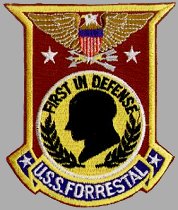 | 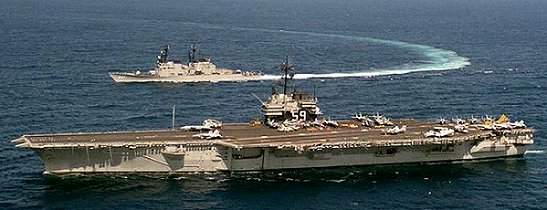 |
USS FORRESTAL was the first "super - carrier" in the world. Commissioned as attack aircraft carrier CVA 59, the FORRESTAL was redesignated as multi-purpose aircraft carrier CV 59 on June 30, 1975. She was the lead ship of the FORRESTAL class of which all four carriers have been decommissioned during the 1990s. After decommissioning, the USS FORRESTAL was used as parts hulk for the other active carriers. For years, the FORRESTAL was laid up at the Naval Station in Newport, RI., and the USS FORRESTAL Museum Inc. tried to purchase the carrier for use as a museum ship in Baltimore, Md. However, the Navy was unwilling to donate the carrier. Instead, the FORRESTAL was towed to the former Philadelphia Naval Shipyard, Philadelphia, Penn., in mid-June 2010, and a contract was awarded to clean up the FORRESTAL in preparation for a SinkEx. The plan to sink FORRESTAL, however, was cancelled in December 2010, and the carrier was subsequently designated to be scrapped. On October 22, 2013, the FORRESTAL was sold for scrapping for the symbolic price of 1 cent to All Star Metals of Brownsville, Tx.
| General Characteristics: | Awarded: July 12, 1951 |
| Keel laid: July 14, 1952 | |
| Launched: December 11, 1954 | |
| Commissioned: October 1, 1955 | |
| Decommissioned: September 11, 1993 | |
| Builder: Newport News Shipbuilding Co., Newport News, Va. | |
| Propulsion system: eight boilers | |
| Rudders: two | |
| Propellers: four | |
| Blades on each Propeller: five | |
| Aircraft elevators: four | |
| Catapults: four | |
| Arresting gear cables: four | |
| Length, overall: 1,063 feet (324 meters) | |
| Flight Deck Width: 250,3 feet (76.3 meters) | |
| Beam: 129 feet (39.3 meters) | |
| Draft: 37,7 feet (11.3 meters) | |
| Displacement: approx. 78,200 tons full load | |
| Speed: 30+ knots | |
| Planes: approx. 85 | |
| Crew: Ship: approx. 2,700 Air Wing: 2,480 | |
| Armament: three |
Crew List:
This section contains the names of sailors who served aboard USS FORRESTAL. It is no official listing but contains the names of sailors who submitted their information.
- Click here to view the list.
- Click here
to see which USS FORRESTAL memorabilia are currently for sale on ebay.
USS FORRESTAL Cruise Books:
- Maiden Cruise Book 1957
- Mediterranean Cruise Book 1958-59
- Mediterranean Cruise Book 1959-60
- Mediterranean Cruise Book 1961
- Mediterranean Cruise Book 1962-63
- Mediterranean Cruise Book 1964-65
- Mediterranean Cruise Book 1965-66
- Vietnam Cruise Book 1967 (FORRESTAL Fire)
- Mediterranean Cruise Book 1968-69
- Mediterranean Cruise Book 1969-70
- Mediterranean Cruise Book 1971
- Mediterranean Cruise Book 1972-73
- Mediterranean Cruise Book 1974
- Mediterranean Cruise Book 1975
- INR and OpSail Cruise Book 1976
- Mediterranean Cruise Book 1978
- Mediterranean Cruise Book 1979-80
- Mediterranean Cruise Book 1981
- Mediterranean Cruise Book 1982
- SLEP Cruise Book 1983-85
- Mediterranean Cruise Book 1986
- Mediterranean Cruise Book 1988
- Mediterranean Cruise Book 1989-90
- Mediterranean Cruise Book 1991
- Decommissioning Cruise Book 1992-93
Notes of Interest:
- Originally the FORRESTAL had three rudders. The center one was later welded into place as part of the keel.
- The contracts originally let for CV 59 and 60 SARATOGA did not include an angled deck in their designs. In 1953 the Navy redesigned the flight deck plans for the FORRESTAL and incorporated an angled landing deck. These changes were also made to the designs for the SARATOGA. The contract for FORRESTAL was awarded in 1951 and for SARATOGA in 1952. The contract for RANGER (CV 61) and INDEPENDENCE (CV 62) were not awarded until 1954. Therefore, the original contract designs for the RANGER and INDEPENDENCE would have included an angled deck. Technically speaking, RANGER and not the FORRESTAL was the first carrier designed and built as an angled deck carrier.
USS FORRESTAL's Commanding Officers:
| Period | Name |
|---|---|
| October 1, 1955 - May 1956 | Captain Roy L. Johnson, USN |
| May 1956 - July 1957 | Captain William E. Ellis, USN |
| July 1957 - July 1958 | Captain Richard E. Kibbe, USN |
| July 1958 - May 1959 | Captain Allen M. Shinn, USN |
| May 1959 - April 1960 | Captain Samuel R. Brown, Jr., USN |
| April 1960 - June 1961 | Captain Robert Riera, USN |
| June 1961 - June 1962 | Captain Donald M. White, USN |
| June 1962 - May 1963 | Captain Lawrence R. Geis, USN |
| May 1963 - March 1964 | Captain Dick H. Guinn, USN |
| March 1964 - March 1965 | Captain Michael J. Hanley, USN |
| March 1965 - May 1966 | Captain Howard Moore, USN |
| May 1966 - September 1967 | Captain John K. Beling, USN |
| September 1967 - December 1968 | Captain Robert B. Baldwin, USN |
| Decemberl 1968 - November 1969 | Captain James W. Nance, USN |
| November 1969 - November 1970 | Captain Charles F. Demmier, USN |
| November 1970 - June 1971 | Captain Leonard A. Snead, USN |
| June 1971 - November 1972 | Captain R. F. Schoultz, USN |
| November 1972 - May 1974 | Captain James B. Linder, USN |
| May 1974 - August 1975 | Captain James H. Scott, USN |
| August 1975 - August 1977 | Captain Joseph J. Barth, Jr., USN |
| August 1977 - March 1979 | Captain Peter B. Booth, USN |
| March 1979 - August 1980 | Captain Edwin R. Kohn, Jr., USN |
| August 1980 - February 1982 | Captain C. E. Armstrong, Jr., USN |
| February 1982 - April 1984 | Captain Bobby C. Lee, USN |
| April 1984 - December 1985 | Captain Daniel R. March, USN |
| December 1985 - July 1987 | Captain Timothy W. Wright, USN |
| July 1987 - February 1989 | Captain John A. Pieno, Jr., USN |
| February 1989 - August 1990 | Captain L. E. Thomassy, Jr., USN |
| August 1990 - January 1992 | Captain Robert S. Cole, USN |
| January 1992 - September 11, 1993 | Captain R. L. Johnson, Jr., USN |
About the Carrier’s Name, about James Vincent Forrestal:
The Honorable James Vincent Forrestal was born in Beacon, New York, on February 15, 1892. After graduating from high school, he attended Dartmouth College and Princeton University. Leaving Princeton in 1915, he worked as both a financial reporter and tobacco salesman until 1916, when he enter the banking business in New York City. At the onset of World War I, Forrestal enlisted in the United States Navy. He was later commissioned a naval aviator and served both in this country and abroad. He was discharged at the rank of Lieutenant in July 1919, and reentered the banking business. In June 1940, he accepted a post as Administrative Assistant to President Roosevelt, serving as a liaison for the President overseeing the National Defense Program. Two months later, Forrestal was appointed to the newly-created office of Under Secretary of the Navy. In this position, he was in charge of a procurement and production program that produced the world's largest Navy.
Forrestal was appointed Secretary of the Navy in may 1944. He then took the oath of office as our country's first Secretary of Defense in September 1947, and served in that capacity until 1949 when failing health forced his resignation. He died on May 22, 1949. A bronze bust of Forrestal at the mall entrance to the pentagon is inscribed as follows: "This memorial to James Forrestal, as a spontaneous tribute to his lasting accomplishments in providing for national security and his selfless devotion to duty, was erected by thousands of his friends and co-workers of all rank and stations." Additionally, a life-size brass bust of Secretary Forrestal has for many years been a fixture on the USS FORRESTAL quarterdeck. This bust serves as a constant reminder of the impressive legacy bestowed upon the ship by it's namesake, as well as the numerous contributions he made to our Navy and our nation's defense program. USS FORRESTAL has long been and forever will be proud to be linked with such a great man, carrying on his indomitable spirit, dignity, and courage as the "First in Defense". On October 1, 1955 Secretary of the Navy, C. S. Thomas, at USS FORRESTAL's commissioning ceremony, perhaps best summarized Secretary Forrestal's myriad achievements: "I welcome the opportunity of paying a personal tribute to my friend, and former superior, the late and genuinely lamented James Forrestal. This nation has never had a more devoted servant, nor one with greater vision than James Forrestal. But for his untiring efforts, brilliance and devotion, our nation would not be enjoying the tenuous peace we have today. It is therefore most fitting and proper that this first new super carrier, representing all the best efforts of industry, science, and the Navy, should carry his name." In addition to the having the world's first supercarrier named for him, Mr. Forrestal has at least one high school, the building that houses the Department of Energy in Washington, D. C., a corporate research park at Princeton University, and a lecture series at the U. S. Naval Academy named for him as well.
USS FORRESTAL Patch Gallery:
 | 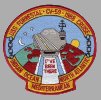 |  | 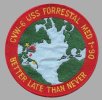 |  |
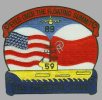 |  |
About the KC-130 landings and take-offs aboard USS FORRESTAL:
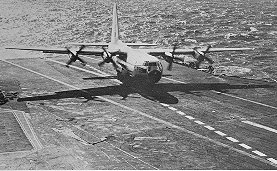
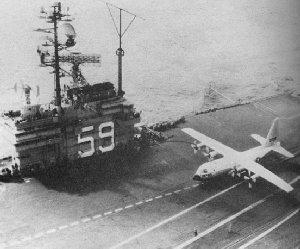 When one reviews the encyclopedic range of accomplishments by the Hercules and its valiant aircrews over the years, surely one of the most astounding took place in October of 1963 when the U.S.Navy decided to try to land a Hercules on an aircraft carrier: Was it possible? Who would believe that the big, four-engine C-130 with its bulky fuselage and 132-foot wing span - could land on the deck of a carrier?
When one reviews the encyclopedic range of accomplishments by the Hercules and its valiant aircrews over the years, surely one of the most astounding took place in October of 1963 when the U.S.Navy decided to try to land a Hercules on an aircraft carrier: Was it possible? Who would believe that the big, four-engine C-130 with its bulky fuselage and 132-foot wing span - could land on the deck of a carrier?
Not only was it possible, it was done, in moderately rough seas 500 miles out in the North Atlantic off the Boston Coast. In so doing, the airplane became the largest and heaviest airplane to land on a U.S. Navy aircraft carrier, a record that holds to this day.
When Lt.James H. Flatley III was told about his new assignment, he thought somebody was pulling his leg: "Operate a C-130 off an aircraft carrier? Somebody's got to be kidding, " he said.
But they weren't kidding. In fact, the Chief of Naval Operations himself had ordered a feasibility study on operating the big propjet aboard the Norfolk-based Forrestal. The Navy was trying to find out whether they could use the big Hercules as a sort of "super-COD" - a "Carrier Onboard Delivery aircraft". The airplane then used was the Grumman C-1 Trader, a twin engine bird with a limited payload and only a 300-mile range. If a carrier is operating in mid-ocean it has no "on board delivery" system to fall back on and must come nearer land before taking aboard even urgently needed items. The Hercules was stable and reliable with a long cruising range and a high payload.
The aircraft, a KC-130F refueler transport (BuNo 149798), on loan from the Marines, was delivered October 8. Lockheed's only modification to the original plane was to install an improved anti-skid braking system, remove refueling pods form the wings and install a smaller nose-landing gear orifice.
"The big worry was whether we could meet the maximum sink rate of nine feet per second," Flatley said. As it turned out, the Navy was amazed to find they were able to better this mark by a substantial margin.
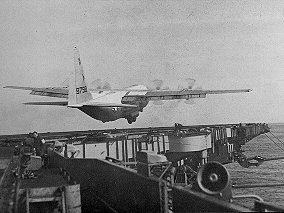 In addition to Flatley, crewmen consisted of Lt.Cmdr. W.W. Stovall, co-pilot; ADR-1 E.F. Brennan, flight engineer and Lockheed engineering flight test pilot Ted H. Limmer, Jr., safety pilot. The initial seaborn landings, on October30, 1963, were made into a 40-knot wind. Altogether, the crew successfully negotiated 29 touch-and-go landings, 21 unarrested full stop landings and 21 unassisted take-offs at gross weights of 85,000 pounds up to 121,000 pounds. At 85,000 pounds, the KC-130Fcame to a complete stop within 267 feet, about twice the aircraft's wing span! The Navy was delighted to discover that even with the maximum load, the plane used only 745 feet for take-off and 460 feet for landing roll. The short landing roll resulted from close coordination between Flatley and Jerry Daugherty, the carrier's landing signal officer. Daugherty, later to become a captain and assigned to the Naval Air Systems Command, gave Flatley an engine "chop" while still three or four feet off the deck.
In addition to Flatley, crewmen consisted of Lt.Cmdr. W.W. Stovall, co-pilot; ADR-1 E.F. Brennan, flight engineer and Lockheed engineering flight test pilot Ted H. Limmer, Jr., safety pilot. The initial seaborn landings, on October30, 1963, were made into a 40-knot wind. Altogether, the crew successfully negotiated 29 touch-and-go landings, 21 unarrested full stop landings and 21 unassisted take-offs at gross weights of 85,000 pounds up to 121,000 pounds. At 85,000 pounds, the KC-130Fcame to a complete stop within 267 feet, about twice the aircraft's wing span! The Navy was delighted to discover that even with the maximum load, the plane used only 745 feet for take-off and 460 feet for landing roll. The short landing roll resulted from close coordination between Flatley and Jerry Daugherty, the carrier's landing signal officer. Daugherty, later to become a captain and assigned to the Naval Air Systems Command, gave Flatley an engine "chop" while still three or four feet off the deck.
Lockheed's Ted Limmer, who checked out fighter pilot Flatley in the C-130, stayed on for some of the initial touch and go and full-stop landings. "The last landing I participated in, we touched down about 150 feet from the end, stopped in 270 feet more and launched from that position, using what was left of the deck. Still had a couple hundred feet left when we lifted off. Admiral Brown was flabbergasted...."
The plane's wingspan cleared the Forrestal's flight deck "island" control tower by just under 15 feet as the plane roared down the deck on a specially painted line. Lockheed-Georgia's chief engineer, Art E. Flock was aboard to observe the testing.
"The sea was pretty big that day. I was up on the captain's bridge. I watched a man on the ship's bow and that bow must have gone up and down 30 feet." The speed of the shop was increased 10 knots to reduce yaw motion and to reduce wind direction. Thus, when the plane landed, it had a 40 to 50 knot wind on the nose.
"That airplane stopped right opposite the captain's bridge," recalled Flock. "There was cheering and laughing. Thereon the side of the fuselage, a big sign had been painted on that said, "LOOK MA, NO HOOK."
From the accumulated test data, the Navy concluded that with the Hercules, it would be possible to lift 25,000 pounds of cargo 2,500 miles and land it on a carrier. Even so, the idea was considered a bit too risky for the C-130 and the Navy elected to use a smaller CoD aircraft. For his effort the Navy awarded Flatley the Distinguished Flying Cross.
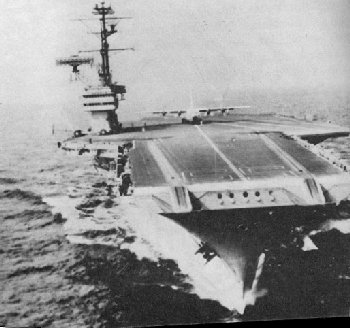
(from Herk: Hero of the skies, by Joseph Earl Dabney, Airlines Publications and Sales, Ltd, 1979. ISBN: 0 932298 02 8)
Accidents aboard USS FORRESTAL:
July 29, 1967 - The worst accident aboard a US Navy surface vessel since WWII.
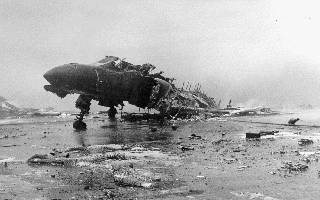
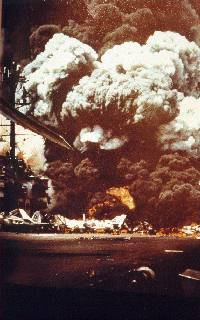 On July 29, 1967 the USS FORRESTAL was operating on Yankee Station off the coast of North Vietnam conducting combat operations. This was the fifth such day of operations and at 10:52am the crew was starting the second launch cycle of the day, when suddenly a Zuni rocket accidentally fired from an F-4 Phantom into a parked and armed A-4 Skyhawk. The accidental launch and subsequent impact caused the belly fuel tank and a 1,000 pound bomb on the Skyhawk to fall off, the tank broke open spilling JP5 (jet fuel) onto the flight deck and ignited a fire. Within a minute and a half the bomb was the first to cook-off and explode, this caused a massive chain reaction of explosions that engulfed half the airwings aircraft, and blew huge holes in the steel flight deck. Fed by fuel and bombs from other aircraft that were armed and ready for the coming strike, the fire spread quickly, many pilots and support personnel were trapped and burned alive.
On July 29, 1967 the USS FORRESTAL was operating on Yankee Station off the coast of North Vietnam conducting combat operations. This was the fifth such day of operations and at 10:52am the crew was starting the second launch cycle of the day, when suddenly a Zuni rocket accidentally fired from an F-4 Phantom into a parked and armed A-4 Skyhawk. The accidental launch and subsequent impact caused the belly fuel tank and a 1,000 pound bomb on the Skyhawk to fall off, the tank broke open spilling JP5 (jet fuel) onto the flight deck and ignited a fire. Within a minute and a half the bomb was the first to cook-off and explode, this caused a massive chain reaction of explosions that engulfed half the airwings aircraft, and blew huge holes in the steel flight deck. Fed by fuel and bombs from other aircraft that were armed and ready for the coming strike, the fire spread quickly, many pilots and support personnel were trapped and burned alive.
Fuel and bombs spilled into the holes in the flight deck igniting fires on decks further into the bowels of the ship. Berthing spaces immediately below the flight deck became death traps for fifty men, while other crewmen were blown overboard by the explosion.
Nearby ships hastened to the FORRESTAL's aid. The ORISKANY (CV 34), herself a victim of a tragic fire in October 1966, stood by to offer fire-fighting and medical aid to the larger carrier. Nearby escort vessels sprayed water on the burning FORRESTAL and within an hour the fire on the flight deck was under control. The crew heroically fought the fire and carried armed bombs to the side of the ship to throw them overboard for 13 hours. Secondary fires below deck took another 12 hours to contain.
Once the fires were under control, the extent of the devastation was apparent. Most tragic was the loss to the crew, 134 had lost their lives, while an additional 64 were injured, this was and still remains the single worst loss of life on a navy vessel since the USS FRANKLIN (CV 13) was bombed in WWII. The ship proceeded to Cubi Point in the Philippines for temporary repairs. In only eight days enough repairs were made that she could start the long trip back to her home port of Norfolk, Virginia for permanent repairs. On her way home she was capable of operating aircraft if needed.
FORRESTAL would spend seven months in the yards being repaired, she was re-built from the hanger up and forward to aircraft elevator number four, this accounts for about 1/5 the ships length and 5 decks. On April 8, 1968 FORRESTAL was once again ready to take her place in the fleet, she was never to return to Vietnam.
With over a dozen major detonations from 1,000 and 500 lb bombs and numerous missile, fuel tank, and aircraft explosions no ship has ever survived the pounding FORRESTAL underwent that day, before or since. She and her crew proved the toughness and dangers associated with the operation of super-carriers, this is one of her greatest legacies. The USS FORRESTAL would go on to serve the United States for another 26 years during the height of the Cold War and see it through to its demise. She and her crew were always ready to go into battle again, the call never came, she served in war for 4 1/2 days but served to ensure peace for over 13,860. FORRESTAL had truly served her purpose as 'First in Defense'.

...other accidents:
| Date | Where | Events |
|---|---|---|
| January 20, 1956 | Naval Base Norfolk, Va. | FORRESTAL collided with the Mine Countermeasures Ship USS PINNACE (MSO 462). The collision caused slight damage to the MSO. |
| September 26, 1957 | Norweign Sea | During a NATO exercise an A-3 aircraft crashed while attempting to land aboard the carrier. |
| October 23, 1957 | North Atlantic | During a NATO maneuver USS FORRESTAL collided with an oil tanker (name not known). The collision caused damage and the carrier had to return to a naval station. |
| March 5, 1962 | Atlantic Ocean | While enroute from Guantanamo Bay to Norfolk, an arresting cable snapped during the landing of an aircraft killing one crew member. 12 other crewmen are injured including one whose left leg had to be amputated. |
| October 3, 1962 | Mediterranean | Airman Irving E. Sheely is killed when he accidentally maneuvers a starter truck into a turning propeller. |
| July 13, 1969 | Norfolk Naval Shipyard | While in dry dock, a load with 2000 aircraft wheels inside caught fire. Eight crewmen were injured and the carrier was damaged. |
| October 1969 | Mediterranean | During a night recovery, an E-2A from VAW-123 comes in nose first, flips over on her back, and breaking off the dome. The aircraft subsequently crashes into the sea and sinks within two minutes. Three of the E-2A's crew are killed, two are rescued. |
| July 10, 1972 | Naval Base Norfolk, Va. | Because of arson there was a fire aboard the carrier while in port. The fire caused heavy damages below the flight deck and many computers were destroyed. The repairs took at least three month. |
| January 15, 1978 | off St. Augustine, Florida | An A-7 aircraft crash-lands on the flight deck killing one and injuring ten. |
| May 21, 1978 | Burning boxes in a storeroom cause widespread smoke on the 3rd deck. Crew called to General Quarters. The fire is put out within ten minutes of the initial alarm. | |
| May 9, 1979 | Caribbean | USS SAVANNAH (AOR 4) collides with the USS FORRESTAL after suffering a gyro casualty while servicing the FORRESTAL in the Caribbean. Both ships suffer minor damage with no personnel casualties. |
| June 26, 1979 | Mayport Naval Station, Fla. | Three minor fires on board. The reason was probably arson. |
| March 13, 1982 | off Guantanamo Bay, Cuba | 14 aircraft from USS FORRESTAL are diverted to Homestead Air Force Base, Florida, after a boiler failure causes a "partial electrical failure" on the carrier. |
| December 31, 1985 | Atlantic | Reduction gear problems force return to port trailing one of the four screws. |
| March 17, 1986 | 100 nautical miles east of Jacksonville, Fla. | During routine flight operations, a KA-6D aircraft catches fire while being readied for launch on catapult 4. The fire is extinguished within 5 minutes. The accident is also featured in FORRESTAL's Mediterranean Cruise Book 1986: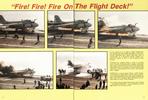 |
| October 9, 1989 | Naval Base Norfolk, Va. | Electrical fire in the forward elevator machinery room injures 9 crewmen. |
| November 8, 1989 | A sailor is fatally injured when a hatch falls on him. | |
| July 8, 1991 | An |
History of USS FORRESTAL:
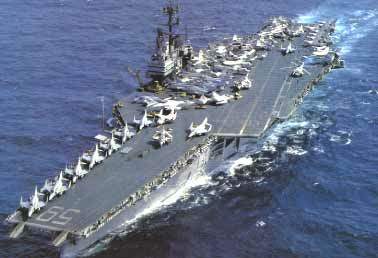
 In July 1951, the Navy announced plans to build a 60,000 ton, 1039 foot carrier designated CVB-59. The keel was laid in July 1952 and less than 30 months later, the first "super-carrier" was christened (by Mrs. James V. Forrestal) USS FORRESTAL. On October 1, 1955 FORRESTAL was commissioned (as CVA 59) and officially joined the fleet. In the Fall of 1956, FORRESTAL was called to assist forces in the Mediterranean during the Suez crisis. From 1958 through 1966, FORRESTAL alternated between the Second Fleet in the Atlantic and the Sixth Fleet in the Mediterranian. On October 30, 1963 a crew led by Lt. James H. Flatley III completed 21 unarrested full stop landings and 21 unassisted take-offs onboard FORRESTAL. This was out of the ordinary because the aircraft used was a KC-130F refueler transport on loan from the Marines as part of a COD (Carrier Onboard Delivery) feasibility study. In so doing, the plane and crew became the largest and heaviest airplane to land on a U.S. Navy aircraft carrier, a record that holds to this day. In June of 1967, she departed Norfolk for duties in the waters off Vietnam. After only 4 1/2 days of combat operations, a tragic fire broke out on the flight deck which claimed 134 crewmen. The entire nation felt the tragedy, summed up in a quote made by Lt. Commander Herbert A. Hope "in five minutes, everyone on this ship became a man", and published by Life Magazine for their.
In July 1951, the Navy announced plans to build a 60,000 ton, 1039 foot carrier designated CVB-59. The keel was laid in July 1952 and less than 30 months later, the first "super-carrier" was christened (by Mrs. James V. Forrestal) USS FORRESTAL. On October 1, 1955 FORRESTAL was commissioned (as CVA 59) and officially joined the fleet. In the Fall of 1956, FORRESTAL was called to assist forces in the Mediterranean during the Suez crisis. From 1958 through 1966, FORRESTAL alternated between the Second Fleet in the Atlantic and the Sixth Fleet in the Mediterranian. On October 30, 1963 a crew led by Lt. James H. Flatley III completed 21 unarrested full stop landings and 21 unassisted take-offs onboard FORRESTAL. This was out of the ordinary because the aircraft used was a KC-130F refueler transport on loan from the Marines as part of a COD (Carrier Onboard Delivery) feasibility study. In so doing, the plane and crew became the largest and heaviest airplane to land on a U.S. Navy aircraft carrier, a record that holds to this day. In June of 1967, she departed Norfolk for duties in the waters off Vietnam. After only 4 1/2 days of combat operations, a tragic fire broke out on the flight deck which claimed 134 crewmen. The entire nation felt the tragedy, summed up in a quote made by Lt. Commander Herbert A. Hope "in five minutes, everyone on this ship became a man", and published by Life Magazine for their.
FORRESTAL deployed to the Mediterranian twelve times between 1968 and 1986. In March 1973, she conducted rescue operations in the flooded Medjerda River Valley near Tunis. In July 1975 FORRESTAL's designation was changed to CV-59, and on July 4, 1976 FORRESTAL was host ship for the International Naval Review in New York City. From FORRESTAL's flight deck President Gerald Ford rang in the nation's Bicentennial and reviewed over 40 "tall ships" from countries throughout the world. FORRESTAL celebrated her silver Anniversary in October 1980. On September 12, 1982, FORRESTAL transited the Suez Canal for the first time in her 28 year history. From January 1983 to May 20, 1985, FORRESTAL underwent a $550 million Service Life Extension Program (SLEP) which was designed to extend her useful life another 15-20 years. In October 1987, FORRESTAL returned from "Ocean Safari '87," a highly successful NATO exercise, operations were conducted above the Arctic Circle and in the fjords of Norway.
FORRESTAL completed her 19th major deployment on October 7, 1988, after operating 108 consecutive days underway, making port calls totaling 15 days and operation in three oceans. For her superior operational performance during the deployment she received the Meritorious Unit Citation. After a brief stand down period and local operations, FORRESTAL participated in New York City's FLEET WEEK in May 1989, and then commenced preperations for her next deployment. FORRESTAL got underway for her 20th major deployment on November 7, 1989 after having completed repairs caused by a fire a month earlier. During the deployment FORRESTAL was visited by President George Bush during his historic Malta Summit with Soviet Premier Mikhal Gorbachev. FORRESTAL returned to her homeport of Mayport, Florida, on April 12, 1990.
From August 1990 through March 1991, FORRESTAL constantly maintained a high state of readiness in anticipation of deployment in support of Operations Desert Shield and Desert Storm. The call never came. FORRESTAL commenced her 21st and final operational deployment on May 30, 1991. During this period she provided air power presence and airborne intelligence support (the airwing flew over 900 sorties over Iraq) to the Combined Joint Task Forces of Operation Provide Comfort enforcing the northern "no-fly zone" in Iraq. During this last deployment FORRESTAL served in a number of new and innovative battle group and carrier roles. She completed this deployment on December 23, 1991. After returning from her final operational deployment FORRESTAL changed homeports from Mayport to Pensacola on February 5, 1992. She was redesignated as AVT 59 (training carrier) , relieving USS LEXINGTON (AVT-16) which was decomissioned after 49 years of service. FORRESTAL served for six months training new naval aviators and providing a platform for carrier qualifications of active duty carrier air wings. During the Summer FORRESTAL and her crew called on the fine citizens of the city of New Orleans as her final liberty port. FORRESTAL was opened up for tours while the crew enjoyed the many flavors of the crescent city. In the late Summer FORRESTAL reported to the Philadelphia Naval Shipyard, Pa., for her final refit as a training carrier. Half way through this $500 million overhaul it was decided the nation no longer needed a dedicated training carrier and she was retired due to budget cuts.
USS FORRESTAL was decomissioned in Philadelphia on 11 September 1993 (effective 9/30/93) and removed from the navy register. On December 5, 1996 a memorial service was held aboard the ship in hangar bay one to remember those who perished at Pearl Harbor. On July 29, 1997 a memorial service was held on the flight deck to remember the 30th anniversary of the fire in the Gulf of Tonkin that claimed 134 crewmembers, the ceremony included a 21 gun salute and a fly-by (with the missing man maneuver) provided by three
For the following years, the FORRESTAL remained at Naval Station in Newport, RI., and the USS FORRESTAL Museum Inc. tried to purchase the carrier for use as a museum ship in Baltimore, Md. However, the Navy was unwilling to donate the carrier. Instead, the FORRESTAL was towed to the former Philadelphia Naval Shipyard, Philadelphia, Penn., in mid-June 2010, and a contract was awarded to clean up the FORRESTAL in preparation for a SinkEx. The plan to sink FORRESTAL, however, was cancelled in December 2010, and the carrier was subsequently designated to be scrapped. On October 22, 2013, the FORRESTAL was sold for scrapping for the symbolic price of 1 cent to All Star Metals of Brownsville, Tx.
Model Gallery:
USS FORRESTAL Image Gallery:
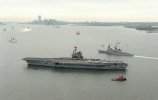 |  | 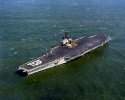 | 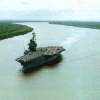 | 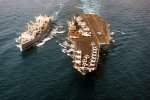 |
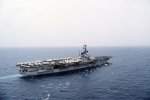 | 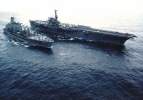 | 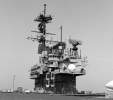 | 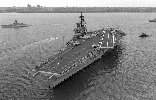 | 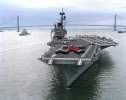 |
 | 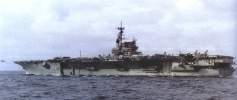 | 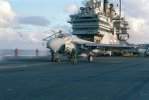 | 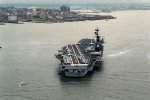 | |
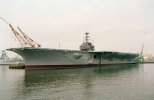 | ||||
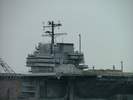
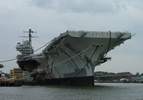

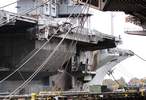
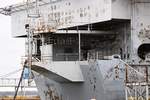
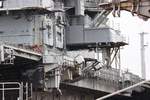
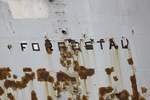
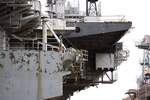
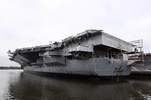
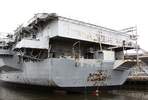
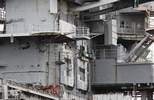
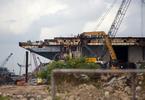
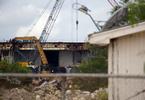
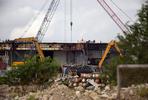
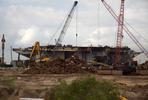
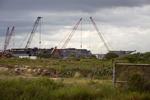
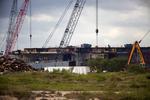
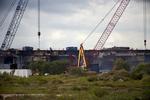
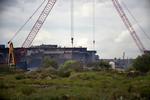
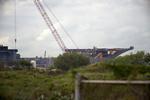
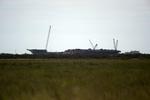
 Back to Carriers list.
Back to Carriers list.